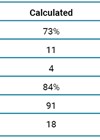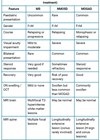Top Tips
Congenital cataract
Congenital cataract is the clouding or opacification of the lens that occurs at birth or weeks after (infantile cataract). They can be unilateral or bilateral and vary in form, size and location, and consequently the visual impact, management course and...
Poppers retinopathy: What is it and how do we treat it?
Poppers retinopathy is a relatively unknown phenomenon which afflicts users of poppers but should be considered as a differential in sudden-onset or sub-acute visual acuity loss – particularly in patients with a history of recreational drug use. Raising awareness of...
Informed consent in ophthalmology care in the UK: A critical component of patient‑centred practice
Informed consent is a cornerstone of ethical and legal practice in healthcare, particularly in fields like ophthalmology where specialised interventions can have significant implications for a patient’s vision and quality of life. In the UK, informed consent is not merely...
Ophthalmic viscoelastic devices: Useful insights for a novice cataract surgeon
Ophthalmic viscoelastic devices (OVDs) are essential in many different stages of cataract surgery. This article discusses the categories of OVDs and their respective properties, and highlights their uses in different scenarios faced in cataract surgery. Ophthalmic viscoelastic devices are gel-like...
The role of aspirin in the treatment of NAION: Benefits and controversies
Non-arteritic anterior ischaemic optic neuropathy (NAION) is the most common acute optic neuropathy in individuals over 50 with estimated prevalence of 2–10 per 100,000 people, characterised by sudden, unilateral vision loss due to ischaemic injury to the optic nerve head....
Step-by-step guide to mastering skills with the Goldmann applanation tonometer
Ophthalmology is a highly specialised field that requires proficiency in various diagnostic skills for numerous conditions. Entrants into ophthalmology at ST1 often possess minimal to no ophthalmic experience beyond what they learned in medical school. Consequently, they may face significant...
Internuclear ophthalmoplegia: a case study
A 44-year-old patient presents with binocular, mostly horizontal diplopia when fixating on moving objects. This has been ongoing for approximately five years. He is known to have multiple sclerosis and had an episode of optic neuritis six years prior in...
Understanding medical negligence in the UK: a brief overview
Medical negligence, or clinical negligence, refers to a breach of duty of care by healthcare professionals that results in harm or injury to a patient. In the UK, medical negligence is a serious issue that can have profound consequences for...
Commonest mistakes during the refraction certificate exam
Ophthalmology specialty trainees are required to pass the refraction certificate exam within the first two years of training. If one passes this exam before entering a training programme, this can add two points to the portfolio during applications. In this...
International medical graduates in ophthalmology
IMGs in the NHS The General Medical Council (GMC) defines an international medical graduate (IMG) as someone who has obtained their primary medical qualification outside the European Economic Area (EEA) [1], meaning that an IMG is a medical doctor whose...
Acetylcholine receptor antibodies in the diagnosis of ocular myasthenia gravis at the Manchester Royal Eye Hospital
Myasthenia gravis (MG) is the commonest autoimmune condition to affect the neuromuscular junction. In the UK, its prevalence is 15 per 10,000 [1,2] and recent studies have shown that rates are steadily increasing [3,4]. Aims of this audit The aim...
Demyelinating optic neuropathy
Introduction Optic neuritis (ON) is an inflammatory process affecting the optic nerve. After glaucoma, it is the most common optic neuropathy affecting patients under the age of 50. The usual presentation of typical ON is unilateral subacute loss of vision...
















